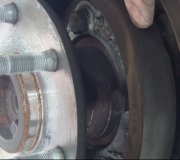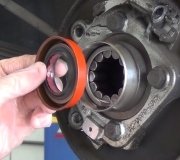Many auto parts stores have brake lathes. I have my own at home so I don't know what those guys charge, but it used to be around ten bucks per rotor. The store you bought the rotors from might do it for free for you but obviously that's not my decision.
Your vehicle has the really simple and reliable parking brake system Chrysler was famous for. It's just a drum brake inside the rotor. It doesn't see the wear that a regular drum service brake gets but the things to check are the same. The shoes will slide up and down a little. The hold-down springs hold them in place once they center themselves in the "hat". That's the drum in the center of the rotor. On regular brakes, those shoes slide out, then retract each time you press the brake pedal, and that causes wear on the backing plates. Each shoe frame has three "lands" that ride on the backing plate. Often you'll see corresponding grooves worn into the backing plates. Brake grease reduces that wear a lot. If those grooves are deep enough, the shoe frames will catch on them and the shoes won't slide smoothly. Under light pedal pressure the shoe can catch and not apply. That will typically prevent that entire brake from applying. The shoe toward the front of the vehicle has a shorter lining. It's only job is to slide forward on top, grab the drum, and try to rotate with it. When it does, it pushes on the lower connector, (usually the star wheel adjuster), which pushes the bottom of the rear shoe into the drum. The wheel cylinder piston pushes the top of the rear shoe into the drum. The rear shoe does all the stopping so it has a longer or thicker lining. If the front shoe hangs up on the grooves, the wheel cylinder will still push the top of the rear shoe into the drum, but the rotational force will just try to push the piston back in. There won't be any stopping power. These grooves in the backing plate are a real big problem on GM vehicles. On Chrysler shoes, those three sliding surfaces are bent-over tabs on the shoe frames. Those spread out the force and greatly reduce the wear on the backing plates.
When the drum is egg-shaped, the shoes slide back and forth when the brakes are applied. If there's grooves in the backing plate, you'll hear the shoes make a clicking noise as they slide over them.
That really should not be a problem with your parking brake setup because those shoes don't move nearly as often as regular brakes. However, there could be some rust buildup that the shoes are sliding over. That rust doesn't cause a problem but it's what can cause noise when a rotor is warped.
To shift gears for a minute, also look at the parking brake lever the cable is attached to. If a cable is sticking and not releasing fully, that lever or the strut bar between the shoes could be rubbing on the hub. Often there will be a "witness mark" in the form of a line rubbed in the rust and brake dust, or a shiny scratch mark showing where something was making contact. You described the noise as a clicking that occurs much more often than once or twice per wheel revolution, and a rubbing parking brake strut bar would do that.
Keep in mind too that nothing related to the parking brake moves when you press the brake pedal. If you identified the noise as coming from the parking brake shoes, look for something allowing the rotor to shift in relation to those shoes.
Also, that high-temperature brake grease should be applied on the hub right where the center hole of the rotor contacts it. Failure to use that on the FRONT of GM front-wheel-drive cars often leads to a crunching sound when cornering at slow speeds, regardless if you're braking or not. Because of that, we are in the habit of using the grease on all slide-on rotors, even on solid rear axles where that is less of a problem. The crunching noise comes from movement between the rotor and hub. You'd think the rotor is clamped tightly with the wheel and lug nuts, but that movement does occur and the grease simply lets it occur without causing noise.
One last thing to look at is inside the drum, on the side of the friction surface closest to the lug nut holes. If you see signs of scratching there, you'll see marks on the outer edges of the shoe frame too. Often, when an inexperienced mechanic machines a drum, he may not start the cut in far enough. The new linings are never exactly the same as the old ones so they can ride on the edge he didn't machine. The same thing can happen with the original shoes and a new drum, as in your case. If the edge of a shoe is making contact with the drum, that will wear away, ... Eventually. But if you can see where it is occurring, you can grind or file the high spot down on the shoe.
Tuesday, December 24th, 2013 AT 8:05 PM


